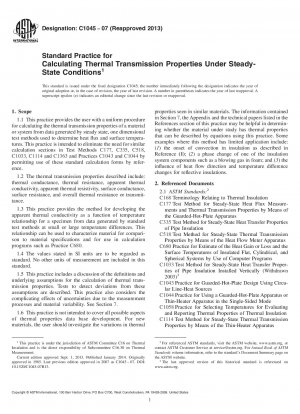ASTM C1045-07(2013)
Standard Practice for Calculating Thermal Transmission Properties Under Steady-State Conditions
- Standard No.
- ASTM C1045-07(2013)
- Release Date
- 2007
- Published By
- American Society for Testing and Materials (ASTM)
- Status
- Replace By
- ASTM C1045-19
- Latest
- ASTM C1045-19
- Scope
4.1 ASTM thermal test method descriptions are complex because of added apparatus details necessary to ensure accurate results. As a result, many users find it difficult to locate the data reduction details necessary to reduce the data obtained from these tests. This practice is designed to be referenced in the thermal test methods, thus allowing those test methods to concentrate on experimental details rather than data reduction.
4.2 This practice is intended to provide the user with a uniform procedure for calculating the thermal transmission properties of a material or system from standard test methods used to determine heat flux and surface temperatures. This practice is intended to eliminate the need for similar calculation sections in the ASTM Test Methods (C177, C335, C518, C1033, C1114, C1199, and C1363) by permitting use of these standard calculation forms by reference.
4.3 This practice provides the method for developing the thermal conductivity as a function of temperature for a specimen from data taken at small or large temperature differences. This relationship can be used to characterize material for comparison to material specifications and for use in calculations programs such as Practice C680.
4.4 Two general solutions to the problem of establishing thermal transmission properties for application to end-use conditions are outlined in Practice C1058. (Practice C1058 should be reviewed prior to use of this practice.) One is to measure each product at each end-use condition. This solution is rather straightforward, but burdensome, and needs no other elaboration. The second is to measure each product over the entire temperature range of application conditions and to use these data to establish the thermal transmission property dependencies at the various end-use conditions. One advantage of the second approach is that once these dependencies have been established, they serve as the basis for estimating the performance for a given product at other conditions. Warning— The use of a thermal conductivity curve developed in Section 6 must be limited to a temperature range that does not extend beyond the range of highest and lowest test surface temperatures in the test data set used to generate the curve.
1.1 This practice provides the user with a uniform procedure for calculating the thermal transmission properties of a material or system from data generated by steady state, one dimensional test methods used to determine heat flux and surface temperatures. This practice is intended to eliminate the need for similar calculation sections in Test Methods C177, C335, C518, C1033, C1114 and C1363 and Practices C1043 and C1044 by permitting use of these standard calculation forms by reference.
1.2 The thermal transmission properties described include: thermal conductance, thermal resistance, apparent thermal conductivity, apparent thermal resistivity, surface conductance, surface resistance, and overall thermal resistance or transmittance.
1.3 This practice provides the method for developing the apparent thermal conductivity as a function of temperature relationship for a specimen from data generated by standard test methods at small or large temperature differences. This relationship can be used to characterize material for comparison to material specifications and for use in calculation programs such as Practice C680.
1......
ASTM C1045-07(2013) Referenced Document
- ASTM C1033 Standard Test Method for Steady-State Heat Transfer Properties of Pipe Insulation Installed Vertically (Withdrawn 2003)
- ASTM C1043 Standard Practice for Guarded-Hot-Plate Design Using Circular Line-Heat Sources
- ASTM C1044 Standard Practice for Using a Guarded-Hot-Plate Apparatus or Thin-Heater Apparatus in the Single-Sided Mode
- ASTM C1058 Standard Practice for Selecting Temperatures for Evaluating and Reporting Thermal Properties of Thermal Insulation
- ASTM C1114 Standard Test Method for Steady-State Thermal Transmission Properties by Means of the Thin-Heater Apparatus
- ASTM C1199 Standard Test Method for Measuring the Steady-State Thermal Transmittance of Fenestration Systems Using Hot Box Methods
- ASTM C1363 Standard Test Method for the Thermal Performance of Building Assemblies by Means of a Hot Box Apparatus
- ASTM C168 Standard Terminology Relating to Thermal Insulation
- ASTM C177 Standard Test Method for Steady-State Heat Flux Measurements and Thermal Transmission Properties by Means of the Guarded-Hot-Plate Apparatus
- ASTM C335 Standard Test Method for Steady-State Heat Transfer Properties of Horizontal Pipe Insulation
- ASTM C518 Standard Test Method for Steady-State Thermal Transmission Properties by Means of the Heat Flow Meter Apparatus
- ASTM C680 Standard Practice for Determination of Heat Gain or Loss and the Surface Temperatures of Insulated Pipe and Equipment Systems by the Use of a Computer Program
- ASTM E122 Standard Practice for Calculating Sample Size to Estimate, With a Specified Tolerable Error, the Average for Characteristic of a Lot or Process
ASTM C1045-07(2013) history
- 2019 ASTM C1045-19 Standard Practice for Calculating Thermal Transmission Properties Under Steady-State Conditions
- 2007 ASTM C1045-07(2013) Standard Practice for Calculating Thermal Transmission Properties Under Steady-State Conditions
- 2007 ASTM C1045-07 Standard Practice for Calculating Thermal Transmission Properties Under Steady-State Conditions
- 2001 ASTM C1045-01 Standard Practice for Calculating Thermal Transmission Properties Under Steady-State Conditions
- 1997 ASTM C1045-97 Standard Practice for Calculating Thermal Transmission Properties Under Steady-State Conditions

Copyright ©2024 All Rights Reserved